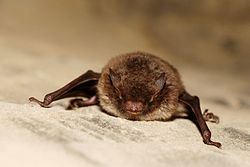| Daubenton's bat | |
|---|---|
 | |
| Scientific classification | |
| Kingdom: | Animalia |
| Phylum: | Chordata |
| Class: | Mammalia |
| Order: | Chiroptera |
| Family: | Vespertilionidae |
| Genus: | Myotis |
| Species: | M. daubentonii |
| Binomial name | |
| Myotis daubentonii (Kuhl, 1817) | |
 | |
Daubenton's bat or Daubenton's myotis (Myotis daubentonii) is a Eurasian bat with rather short ears. It occurs across Eurasia, from Ireland in the west to Hokkaido in the east, and is believed to be increasing its numbers in many areas of its range.
Contents
- Description
- Lifespan
- Habitat
- Hunting and diet
- Breeding
- Conservation
- See also
- References
- External links
This bat was first described in 1817 by Heinrich Kuhl, who named it in honour of French naturalist Louis-Jean-Marie Daubenton.

